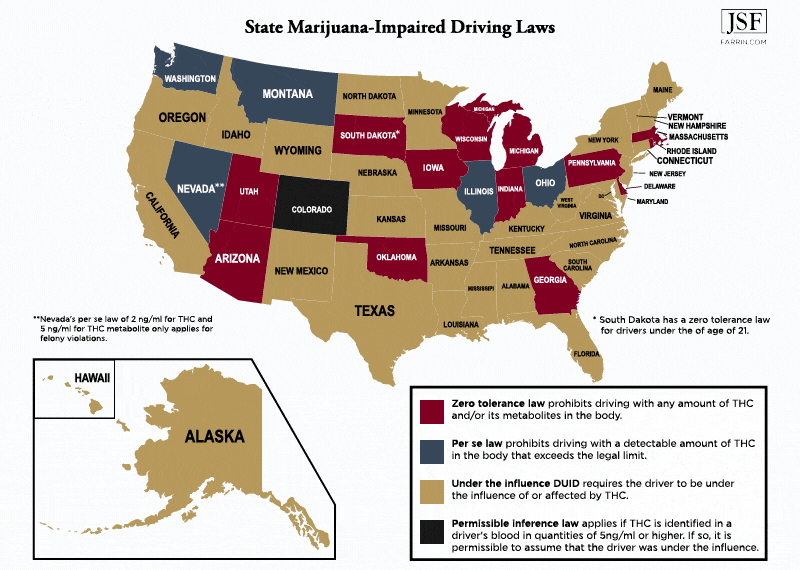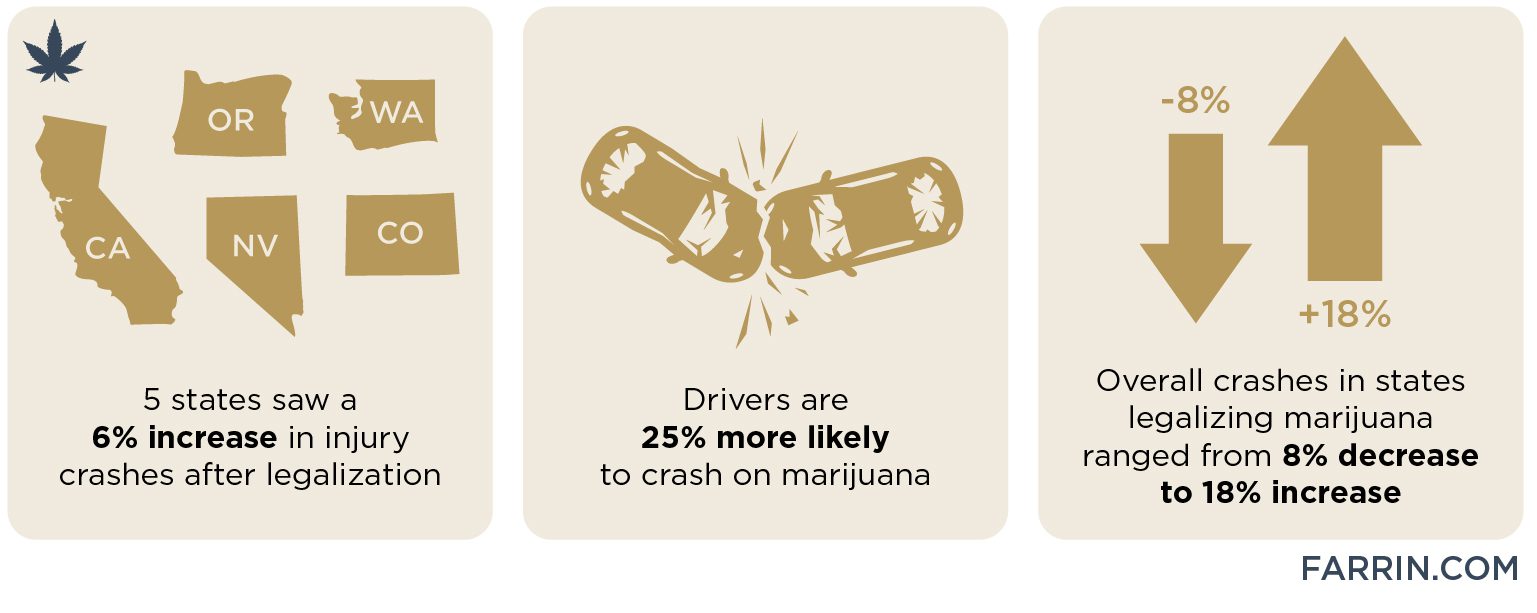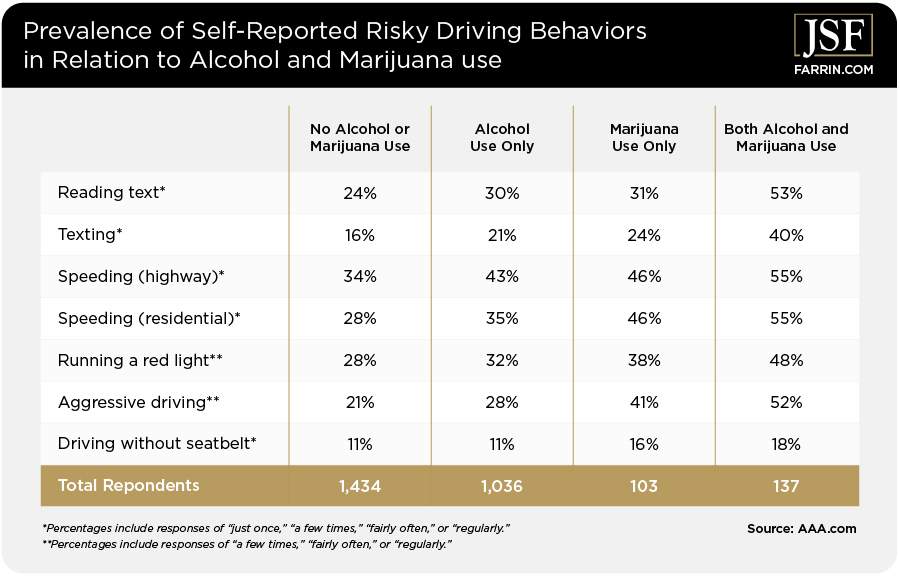Recreational marijuana use is still illegal in North Carolina and South Carolina, and medical marijuana use legislation – though it had bipartisan support in both states – has stalled. While I don’t have a dog in this fight, it did get me thinking about something I deal with every day: car accidents and injury victims.
Specifically, what’s been happening on the roads in states where marijuana legalization has occurred on some level – recreational or medical? And what can those statistics teach us about the road ahead?
As an attorney licensed in North Carolina, I cannot give legal advice in other states, and this blog isn’t legal advice either – it represents my observations, perspective, and some information you may find valuable as an accident injury victim.
Legal Marijuana: A Snapshot
Thirty-seven states have legalized medical cannabis, and 19 allow recreational marijuana use. But this didn’t all happen at once. Some states legalized marijuana years ago, and some are just now passing legislation. Now that we have a large set of data, there are some statistically significant insights that we can draw.
NOTE: The term “marijuana” is a sort of placeholder for the active ingredient, THC. The law may not care how it is consumed – smoking, gummies, or edibles.
A Word on Recreational Marijuana vs. Medical Marijuana in Car Crashes
I want to note that the studies I was able to find were based on the general “legalization” of marijuana or the more specific “legalized recreational marijuana.” None of the studies I read were aimed specifically at medical marijuana users.
According to a study found in the National Library of Medicine, 17% of adult cannabis users were solely medical cannabis users. But the type of usage isn’t particularly relevant. When the government measures accident causes, it denotes drug use – not the purpose of the drug in question. The data eliminates a possible differentiating factor between medical and recreational users.
All this means we’re essentially lumping medical users with recreational users in terms of causing crashes, and that’s not without merit. In a 2019 survey of medical marijuana users in Michigan, more than half admitted to driving while high, and 20% admitted to driving while “very high.”
What a Car Crash Injury Victim Should Know if They Suspect the Other Driver Was High
DWI/DUI due to drug usage of any type is generally more difficult to prove than DWI/DUI due to alcohol. Marijuana can be even more challenging to prove compared to other drugs because it can stay in your system so long. If you are injured due to the other driver potentially being impaired with drugs, especially marijuana, it is vitally important you call an attorney right away.
Impaired Driving Vs Drunk Driving
One final note on terminology. You have probably seen a lot of terms about driving under the influence of drugs or alcohol. “Driving under the influence” (DUI) is a broad descriptor, as is “driving while impaired” (DWI). Both refer to someone whose ability to drive has been reduced by drugs or alcohol. The term “drunk driving” is more specific, referring to the presence of alcohol.
Marijuana Legalization, Laws, and Driver Capabilities

Let’s begin with how the law treats drivers under the influence of marijuana.
The Law, Drivers, and THC
States have varying ways of regulating drivers who are under the influence of tetrahydrocannabinol (THC), the psychoactive substance in marijuana. It is vital to note that, unlike alcohol, there is not a nationally-recognized threshold for being “legal impaired” by THC. Whereas the blood-alcohol content of 0.08 (milligrams per deciliter) is the legal limit for booze, THC has no such recognized amount. That leaves it up to states to set their own rules.
Per Se Laws
In some states, the law prohibits driving when there is a specific detectable amount of THC in the body: the so-called “legal limit.” This legal limit is set by the state and “per se” means the presumption of guilt. In other words, if you have the specified amount of alcohol or THC in you, you can be convicted of driving under the influence, even if it cannot be proven that you were “under the influence” of the substance and impaired by it.
Zero Tolerance Laws
In some states, the legal limit of THC in the system is zero. Put another way, if you have any THC in your system, you’ve exceeded the per se limit of zero. It’s worth noting that these laws exist in some states where marijuana is legal to use.
Under the Influence Laws
In some states, the driver must be demonstrably “under the influence” of or “affected by” a substance in order to be convicted. Every state sets its own thresholds and tests for determining if a driver is “under the influence,” which may include specified amounts of the substance in the system. North and South Carolina have this type of law in place.
What’s the THC Legal Limit for Drivers?
Unlike alcohol, there is no national per se or legal limit for THC. It is plausible that a driver might be under the limit in one state and not in another. Different states have different limits, and things are continually evolving. Even if there were a uniform limit, it could not be uniformly enforced because different states have different testing methods.
Compounding the confusion is the fact that THC metabolizes rapidly. While THC levels spike during the act of consumption and for perhaps 30 minutes after, the level of THC declines rapidly thereafter.
For example, in Colorado, the limit of THC concentration in the body before impairment is 5 ng/ml (nanograms per milliliter). In one study quoted by the National Highway Traffic and Safety Administration (NHTSA), peak plasma THC concentrations were recorded at 48-188 ng/ml over a ten-minute smoking session. That level can drop to 5 ng/ml in just three hours.
In North Carolina, there is no per se limit. Roadside and blood tests are used to determine the presence and influence of marijuana. In South Carolina, there is also no per se limit. Roadside tests are performed, and a urine sample can be taken.
Testing Positive
“Testing positive” for the drug is also fraught with variables. It can be found in blood, urine, and saliva. Tests that are not performed on the spot – or at least with samples not taken immediately – risk being inaccurate, as it is difficult to establish concentration levels over time due to the way THC levels drop.
Further, different people react differently to the drug, making it harder to prove impairment in some states. Plus, there are different strains of marijuana, and they vary in their potency, which may affect who might test positive and for how long.
If you want to know if there is a local “limit” for being under the influence of marijuana, your state’s Department of Justice or Department of Transportation should publish that information.
How Does Marijuana Affect Drivers?
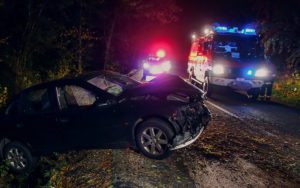
The National Library of Medicine states that “Attentiveness, vigilance, perception of time and speed, and use of acquired knowledge are all affected by marijuana; in fact, a meta-analysis of 60 studies concluded that marijuana causes impairment in every performance area that can reasonably be connected with safe driving of a vehicle, such as tracking, motor coordination, visual functions, and particularly complex tasks that require divided attention.”
Despite many users of cannabis believing that their driving skills are unaffected, there is significant evidence to the contrary. However, exactly how people drive under the influence of marijuana is apparently different than how people drive under the influence of alcohol.
A study published in the BC Medical Journal found:
“In experimental driving conditions, cannabis users tend to reduce their driving speed and are less likely to attempt to overtake and pass another vehicle, whereas drunk drivers tend to drive faster and more aggressively. Furthermore, cannabis users tend to overestimate their impairment whereas people who used alcohol underestimate theirs.”
Despite these cautious – dare I say mellow – tendencies among cannabis users, surveys indicated that users were more likely to be involved in crashes than non-users.
Marijuana Use in Drivers Involved in Injury Crashes
There are basically three types of crashes. PDO, or property damage-only, crashes are your typical fender benders. Injury crashes are those that involve some level of injury to one or more persons in the crash. Fatality crashes involve the death of one or more persons in the crash.
A few studies have been conducted to ascertain the effect of marijuana on crashes with injuries. The methodologies differ. An Insurance Institute for Highway Safety study of injured drivers who visited emergency rooms in California, Colorado, and Oregon showed that drivers who used marijuana were more likely to be involved in a crash than those who had not used the drug.
Another study sought the impact of legalization and retail sales in five states – Colorado, California, Oregon, Washington, and Nevada. After recreational legalization, those states experienced a 6% increase in injury crashes as compared to neighboring states where recreational marijuana was not legalized.
According to data from the Centers for Disease Control (CDC), drivers on marijuana were about 25% more likely to be involved in a crash than drivers without the drug in their system.
And, according to data from a study published in the Journal of Studies on Alcohol and Drugs, legalization of recreational marijuana was associated with a 6.5% increase in injury crashes overall. However, the rates differed among states across a wide range – from an 8% decrease in injury crashes to an 18% increase.
Marijuana Use in Drivers Involved in Fatal Crashes
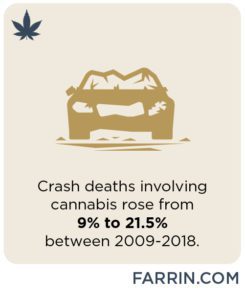
A separate study analyzed nearly 20 years of data from the national Fatality Analysis Reporting System (FARS). The analysis found that the number of crash deaths involving cannabis rose from 9% in 2000 to 21.5% in 2018.
Marijuana Use and Alcohol Use Combined
What happens when alcohol is combined with marijuana, and the user jumps behind the wheel? Nothing good, according to the data. A study from the National Library of Medicine concluded that there was an increased risk of fatality:
“When alcohol and marijuana are used together, there exists a positive synergistic effect on fatal crash risk.”
In the FARS study mentioned above, the data showed that at the same time marijuana use was contributing to more crash fatalities, fatal crashes involving the combination of cannabis and alcohol more than doubled.
To make matters worse, a AAA study asked U.S. drivers over 16 years of age to self-report their behaviors in a survey published in 2021. It seems that drivers who consumed both alcohol and marijuana were far more likely to drive under the influence of other substances, and with other dangerous drivers.
Drivers who used both alcohol and marijuana at the same time were:
- More than 2x as likely to drive under the influence of alcohol alone
- About a 1/3 more likely to drive under the influence of marijuana alone
- Roughly 5x as likely to drive under the influence of prescription drugs
- About 3x as likely to ride with a driver who was under the influence of marijuana or alcohol
- About 50% more likely to drive while drowsy
Furthermore, the same study indicated that drivers who used both alcohol and marijuana were more likely to engage in distracted or other dangerous driving behaviors:
What Can We Learn From the Data on Marijuana and Car Accidents?
We know more people are open about using marijuana than ever before. This likely means more people are using marijuana prior to driving than before, which would lead to more impaired drivers on the road compared to years past.
Regardless of your stance on legalized marijuana, there are some disturbing crash trends in the data from states that allow it. Crash risk has apparently risen – injury crash rates increased on average as did fatal crashes in states with legalized marijuana. The information, however, was not uniform. There were states where crash rates decreased.
After all of this research, I’m left with a few takeaways.
First, the non-uniform effect of marijuana on users makes it incredibly difficult to truly pin down a threshold.
Second, the difficulty in testing for the drug makes it difficult to draw a conclusive, consistent approach.
Third, the presence of THC in any amount could very well have a negative effect on the capabilities of a driver – even though the drug affects different people in different ways.
Finally, states considering marijuana legalization, including North and South Carolina, have the benefit of learning from the states who have already done so. While Colorado and Washington have dealt with spikes in crashes, injuries, or fatalities – or a combination of the three – states like Nevada have seemingly solved the puzzle and suffered no such consequences.
Does it matter if marijuana legalization is medicinal versus recreational? It’s hard to say. Regardless, public education about the dangers of driving under the influence of marijuana could be helpful considering the apparent belief that the drug doesn’t affect driving skills.
One thing is for certain, though. It is irresponsible to drive when you’re under the influence of marijuana. This can lead to catastrophic consequences for other innocent road users. And while the law may be fuzzy on what is or is not criminal in such cases, a civil court jury could easily take a dim view of it.
My job as a personal injury attorney is to help people who were hurt by the negligence of others. So if you choose to use marijuana, use it responsibly. Stay off the road. Because if you hurt someone, they may contact us.
And we mean business.
You May Also Be Interested In
The Ultimate Guide to North Carolina DWI Law
Driving Under the Influence: New Study Reveals Staggering Rates
Drowsy Driving: Danger on the Road
What Impact Does Alcohol and Drug Use Have on NC Road Safety?



